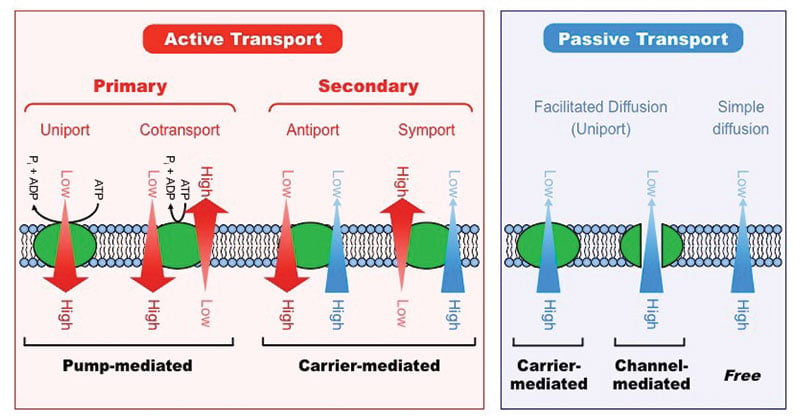Active and passive transport are the two main biological process which plays an important role in supplying nutrients, water, oxygen, and other essential molecules to cells and also by removing waste products.
- Both active and passive transport works for the same cause, but with different movement.
- Active transport requires chemical energy because it is the movement of biochemicals from areas of lower concentration to areas of higher concentration.
- On the other hand, passive transport moves biochemicals from areas of high concentration to areas of low concentration; so it does not require energy.

Image Source: BIONINJA
Interesting Science Videos
Key differences (active transport vs passive transport)
| S.N. | Character | Active Transport | Passive Transport |
| 1. | Definition | The movement of molecules across the cell membrane, pumping the molecules against the concentration gradient using ATP (energy) is called Active transport. | The movement of molecules within and across the cell membrane and thus transporting it through the concentration gradient, without using ATP (energy) is called Passive transport. |
| 2. | Energy requirement | Energy is required which is in the form of ATP. | No energy is required. |
| 3. | Concentration Gradient | The movement of molecules is from low concentration to high concentration which means they move against the concentration gradient. | The movement of molecules is from high concentration to low concentration, which means they move along the concentration gradient. |
| 4. | Direction of movement | With the use of ATP, it pumps the molecules upwards. | In this, the molecules are moved downwards. |
| 5. | Carrier Protein or Pumps | Active transport requires carrier proteins. | In passive transport carrier proteins are not involved. However, in facilitated diffusion certain channels are present which utilize no energy. |
| 6. | Involvement of matrix or permeases | Matrix or permeases of the membrane are not involved. | It takes place through matrix/channels/permeases. |
| 7. | Efficiency of the Process | It is a rapid process. | It is comparatively a slow process. |
| 8. | Principle of Working | Active transport allows molecules to pass the cell membrane, disrupting the equilibrium established by the diffusion. | A dynamic equilibrium of water, nutrients, gasses, and wastes is maintained by passive transport
Between cytosol and extracellular environment. |
| 9. | Directionality | Occurs in one direction. | Bidirectional process. |
| 10. | Process type | Active transport is a vital process. | Passive Transport is a physical process. |
| 11. | Selectivity | It is highly selective. | It is partly non-selective |
| 12. | Effect of Temperature | Affected by temperature. | Not affected by temperature. |
| 13. | Effect of Oxygen Level | This process reduces or stops as the level of oxygen content is reduced. | This process is not affected by the oxygen content. |
| 14. | Effect of metabolic inhibitors | Metabolic inhibitors stop the active transport. | Metabolic inhibitors do not influence passive transport. |
| 15. | Molecules Transported | Macromolecules like proteins, carbohydrate (sugars), lipids, large cell are few of the materials which are transported by this way. | Oxygen, monosaccharides, water, carbon dioxide, lipids are the few soluble materials which are being transported through this way. |
| 16. | Types | Active transport is classified into two categories, like primary active transport and secondary active transport.
Endocytosis, cell membrane/sodium-potassium pump & exocytosis | Passive transport is classified into four categories like osmosis, diffusion, facilitated diffusion, and filtration. |
| 17. | Functions | Though the function of both types of transport is to carry ions and molecules, separately active transport is used to carry through the cell membrane. | It is used to maintain the equilibrium, within and outside the cell of nutrients, water and gases, etc. |
| 18. | Examples | Examples of active transport include a sodium pump, glucose selection in the intestines, and the uptake of mineral ions by plant roots. | Passive transport occurs in the kidneys and the liver, and in the alveoli of the lungs when they exchange oxygen and carbon dioxide. |
References
- https://www.enotes.com/homework-help/what-three-differences-two-similarities-between-50965
- https://biodifferences.com/difference-between-active-and-passive-transport.html
- https://byjus.com/biology/difference-between-active-and-passive-transport/
- https://sciencing.com/difference-between-active-passive-transport-processes-10031095.html
- https://www.diffen.com/difference/Active_Transport_vs_Passive_Transport
- http://www.biologydiscussion.com/difference/difference-active-transport-and-passive-transport-of-cells/70415
- https://www.thoughtco.com/active-and-passive-transport-603886
- https://www.researchgate.net/publication/316786043_Difference_Between_Active_and_Passive_Transport
- https://socratic.org/questions/what-is-the-difference-between-passive-and-active-transport
